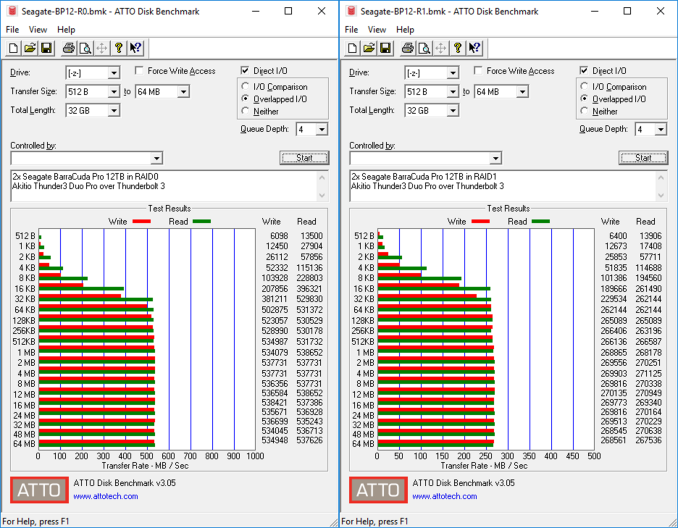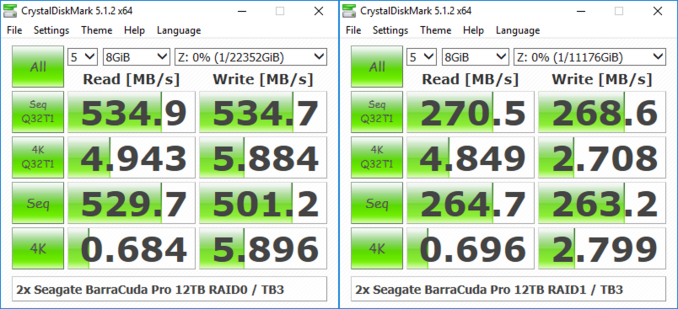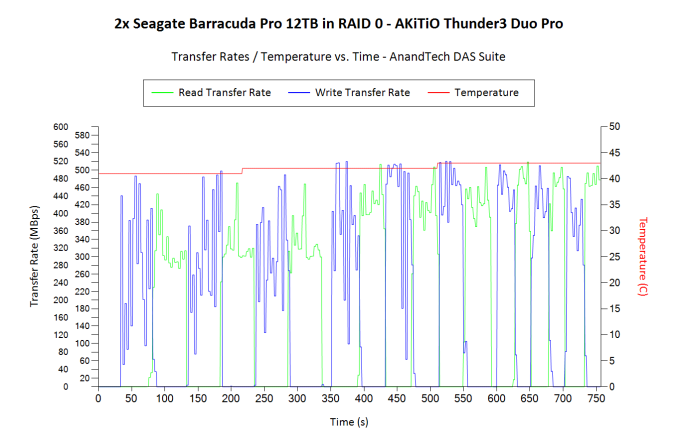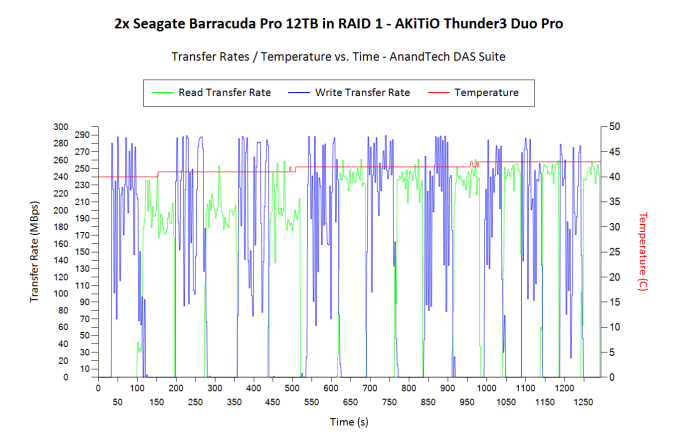Seagate BarraCuda Pro 12TB HDD Review
by Ganesh T S on November 15, 2017 8:00 AM EST- Posted in
- Storage
- Seagate
- HDDs
- Helium HDD
Performance - Direct Attached Storage Mode
Seagate suggests that the BarraCuda Pro Compute drives are suitable for use in direct-attached storage systems. We evaluated the performance in such a usage scenario using one of the highest performing 2-bay DAS units currently in the market - the Akitio Thunder3 Duo Pro, connected to our testbed via a Thunderbolt 3 interface.
Prior to processing real-life workloads, we first checked quick artificial access traces using ATTO and CrystalDiskMark.
We find that the performance remains consistent irrespective of workload size as long as the sequential access characteristic holds. Two drives in RAID 0 can sustain 530 MBps+ reads and writes. RAID 1 performance is similar to the standalone drive performance.
Both RAID0 and RAID1 configurations were subject to our standard DAS test suite described in the previous section. The robocopy test suite gave the following results.
| Akitio Thunder3 Duo Pro + 2x Seagate BarraCuda Pro 12TB (Thunderbolt 3) robocopy Benchmarks (MBps) |
||||
| Write Bandwidth | Read Bandwidth | |||
| RAID 0 | RAID 1 | RAID 0 | RAID 1 | |
| Photos | 334.00 | 215.79 | 303.85 | 184.12 |
| Videos | 432.76 | 221.45 | 396.39 | 222.44 |
| Blu-ray Folder | 421.10 | 219.98 | 434.73 | 224.72 |
There is no difference in the performance consistency between either RAID configuration. The behavior is largely similar to the internal drive scenario, except for the RAID 0 absolute bandwidth numbers. Thanks to the enclosure's fan, the temperature increase is also not as much as what we observed in the internal drive case.
We also processed select workloads from PCMark 8's storage bench.
| Akitio Thunder3 Duo Pro + 2x Seagate BarraCuda Pro 12TB (Thunderbolt 3) PCMark8 Storage Benchmarks (MBps) |
|||||
| Write Bandwidth | Read Bandwidth | ||||
| RAID 0 | RAID 1 | RAID 0 | RAID 1 | ||
| Adobe Photoshop (Light) | 313.76 | 201.22 | 10.51 | 9.16 | |
| Adobe Photoshop (Heavy) | 304.70 | 196.83 | 12.46 | 10.99 | |
| Adobe After Effects | 95.00 | 74.12 | 9.75 | 9.54 | |
| Adobe Illustrator | 214.10 | 168.92 | 9.39 | 9.11 | |
A significant speed-up in response time is achieved while dealing with multimedia files stored in a RAID 0 configuration of two BarraCuda Pro 12TB drives in a Thunderbolt 3 enclosure. Combined with the consistency shown, we can say that our results back up Segate's claims regarding the firmware tuning of BarraCuda Pro drives for specific application scenarios.














62 Comments
View All Comments
phoenix_rizzen - Wednesday, November 15, 2017 - link
Go read through some of the quarterly drive reports from Backblaze. The larger sized Seagates are much more reliable than the earlier 1-3 TB drives. Although Toshiba and Hitachi are still the drives to beat for reliability.artk2219 - Wednesday, November 15, 2017 - link
Hey Ganesh, thank you for the review, honestly i'm always surprised by how much faster hard drives are now than they were even 5 years ago. On an unrelated question, how do you like that cooler master case? I've been considering getting one recently for its openness but I wasn't sure about whether or not i could get used to how much horizontal space it takes up on a desk.ganeshts - Wednesday, November 15, 2017 - link
I simply love it, but, I have to let you know that my requirements are not the typical computer builder's requirements.I wanted something that could be used to easily hot-swap hard drives (since I tend to benchmark internal drives quite a bit) - the two front bays serve this purpose well.
I wanted it to be fairly portable - the 'carry handles' on either side have been put to use many times and have worked well.
There is plenty of ventilation, but, to be honest, I am not overclocking, and I don't even have a dGPU in that build. So, I really can't comment on that aspect.
Lastly, I wanted a LAN box rather than a tower because I wanted all the ports to be easily accessible when placed in makeshift 'rackmount' environments. Currently I have it in a repurposed garage shelving unit [ https://www.walmart.com/ip/Edsal-36-W-x-18-D-x-72-... ].
artk2219 - Wednesday, November 15, 2017 - link
Minus the moving those were also my considerations. I'm constantly swapping and playing with different GPU's and CPU's so the ability to just open the top and be there is a big plus. I tend to not keep the exact same config for too much time, and in the time ive had my current corsair carbide 500r, ive gone through 2 motherboards, 4 different cpu's, 5 GPU's, and multiple hard drives. Not to mention all of the parts i've just tested to verify that it works for family and friends. Normally I keep cases for 5 to 7 years or until they've just had enough, but since I saw this case it seemed like it would be perfect for the sort of use I have in mind, especially now that AM4 seems like it'll have quite a few options available to it like AM2+ and AM3+ did, and I'm building up an AM4 build with an Athlon x4 950. I honestly haven't found a good review of one, and its cheap enough for me to just get one to play with while I see whether or not i want to spring for a 1600, 1700, or just wait for the refresh, although it is slower than my FX 8320 @4.4. Thanks for the information though!Liltorp - Thursday, November 16, 2017 - link
All my important data (around 75GByte) I have in 4 copies. One copy on my personal PC, one copy on my home NAS hidden away, one copy in Google Drive and one copy on an external harddisk that I keep at my workplace. Location redundance is important.My less-imprortant data (around 5TByte mainly video material) I have in 2 copy. One copy on my personal PC and one copy on my home NAS.
chrysrobyn - Thursday, November 16, 2017 - link
I find these types of benchmarks far less interesting than the SSD benchmarks Anandtech uses. I know spinners would get blown out of the water by the top end SSDs on The Destroyer, but I do wonder how the fastest spinners would compete with the lowest end SSDs. Spinning media has its place in this world, and I'd really like to see benchmarks that tell that story.b1gtuna - Thursday, November 16, 2017 - link
Would anyone use this without redundancy? It is nice that they throw in 2 years of data recovery as part of the warranty, but I am genuinely curious if the drive technology has matured enough to guarantee safety from data loss.jameskatt - Sunday, November 19, 2017 - link
I hope one of these days 12 TB drives are < $100.Beaver M. - Sunday, November 19, 2017 - link
They would be in a few years. But not with this oligopoly. Even 8 TB ones are still extremely expensive, and those are over 3 years old now.stevenrix - Tuesday, November 21, 2017 - link
Seagate drives? Thanks but no thanks.